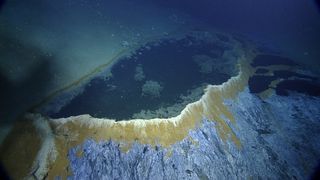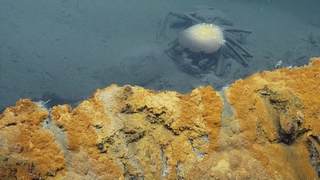Hot Tub of Despair: The deadly ocean pool that traps and pickles creatures that fall in
This stagnant brine pool at the bottom of the Gulf of Mexico is so toxic it kills and embalms any crabs and amphipods that are unlucky enough to stumble into it.

Name: Hot Tub of Despair
Location: Off the coast of Louisiana in the Gulf of Mexico
Why it's incredible: The brine pool is peppered with the carcasses of animals that were unlucky enough to enter the deadly waters.
The "Hot Tub of Despair" is a deadly pool of extremely salty water at the bottom of the Gulf of Mexico. The conditions are so toxic, only bacteria and a handful of animals can survive.
Researchers discovered the hot tub during a 2015 expedition investigating cold seeps in the depths of the Gulf. Cold seeps are places where hydrocarbons — the principal constituents of oil and gas — escape from the seafloor and enter the water column. In the Gulf of Mexico, hydrocarbons are forced out by shifting slabs of salt in Earth's crust that formed as water evaporated from an ancient sea millions of years ago.
Related: Underwater robot in Siberia's Lake Baikal reveals hidden mud volcanoes — and an active fault
The expedition team dubbed this particular cold seep the Hot Tub of Despair after they spotted pickled crabs and various other creatures lying dead inside the bowl-shaped pool. The seep sits nearly 3,300 feet (1,000 meters) below the waves and measures 100 feet (30.5 m) in circumference and 12 feet (3.7 m) deep, according to Nautilus Live.
The hot tub's salty waters, or brine, result from the hydrocarbons bubbling up through the buried slabs of salt, according to a summary of the expedition published in 2016 in the journal Oceanography. The brine is up to four times more salty, and therefore far denser than the seawater around the cold seep, preventing the two from mixing.
Water temperatures inside the pool reach up to 66 degrees Fahrenheit (19 degrees Celsius), which, together with high salinity, creates deadly conditions for most organisms. The brine also contains high levels of hydrogen sulfide and methane, which only certain creatures like mussels can tolerate.

The pool is enclosed by steep "walls" that are encrusted with red, yellow and white mineral flows, as well as mussel beds, according to the summary. "The rim rises pretty sharply," a researcher said in a video of the discovery, which was made using a remotely operated vehicle (ROV). "The mussels, they've done a really standup job at keeping the walls intact."
Sign up for the Live Science daily newsletter now
Get the world’s most fascinating discoveries delivered straight to your inbox.
In the video, the ROV encounters an overflow, where the brine inside the pool spills over the rim like a waterfall. The researchers also point out "embalmed" creatures inside the pool.
Animals likely engineered the pool, one researcher explains in the video. "Initially, probably what happens is fluid starts to erupt from the seafloor," the researcher says. "And then you get biological communities that start taking advantage of that."

Sascha is a U.K.-based trainee staff writer at Live Science. She holds a bachelor’s degree in biology from the University of Southampton in England and a master’s degree in science communication from Imperial College London. Her work has appeared in The Guardian and the health website Zoe. Besides writing, she enjoys playing tennis, bread-making and browsing second-hand shops for hidden gems.
Most Popular


